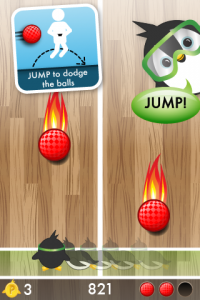
by Annie | Oct 27, 2011 | Game Design
We released Pop & Dodge on the App Store about a week ago. No marketing, no launch parties, just put it out there. The result? Pretty much as expected, Pop & Dodge is nowhere to be found on any featured or top 25 lists. In the wake of the release, we’ve been doing a lot of marketing catch up work, submitting the game to different blogs and review sites. A few, including Tech Vibes, have agreed to post reviews. But how much will that help in getting our game out there? According to the lessons learned from other indie app developers, likely not much. It takes high production values, lots of content, and a wickedly good game to sustain the buzz it takes to keep people coming back to your game. And with our 3-week production cycle, we just didn’t quite make it there. However, this is just the beginning. We’ve learned a lot from MotionMaze and Pop & Dodge, about gameplay, tech requirements, and our market. We have a firmer grasp on our goals and limitations and take our lessons with us into our next...

by Annie | Oct 20, 2011 | Game Design
I’m going to take a wild guess that you like penguins. I know, it’s a bit presumptuous of me, but really. How can you not love flightless waddlers perpetually dressed in tuxes? And while I’m at it, I’m also going to assume that you possess some fondness, however minute, for the game of dodgeball. Add them up and what do you get? Pop & Dodge. Pop & Dodge is a physical activity game in which you stand up and jump to move Beeker the Penguin side to side to avoid getting hit by oncoming dodgeballs. Time your jumps just right, and you can also pick up coins and powerups along the way. Have an iPod, iPad or iPhone? Go try it out now, and let us know what you think!...
![Double Helix]()
by Annie | Nov 29, 2010 | Game Design
What could be more fun than rhythm platforming on DNA strands? That’s the main premise behind my latest game concept, Double Helix. Double Helix is a run-forever rhythm platform game for iOS devices that combines the principles of real world DNA replication with the challenges of quick decision-making. In Double Helix, you play as Junior, a nanobot moving at a certain pace along an unwinding DNA double helix and replicating sequences of DNA to a certain beat. As the double helix unwinds, targets appear indicating missing nucleotides. Using clues in the sequence, you must find the correct nucleotide for each missing spot while staying on the beat. As it turns out, it takes a lot of minute details and tuning to create a game. Even for this deceptively simple game, the breakdown of individual game mechanics within my detailed design document has grown to well over half a dozen pages. Throw in descriptions of characters, enemies, features, controls, camera, and screen mockups, and you’ve got quite a large document on your hands. Here are some initial menu screen mockups for Double...




